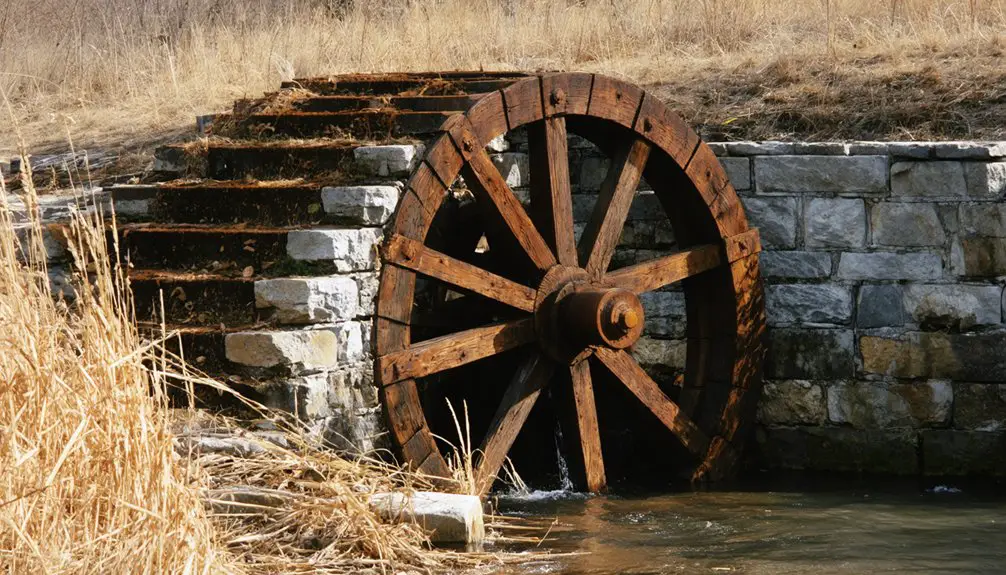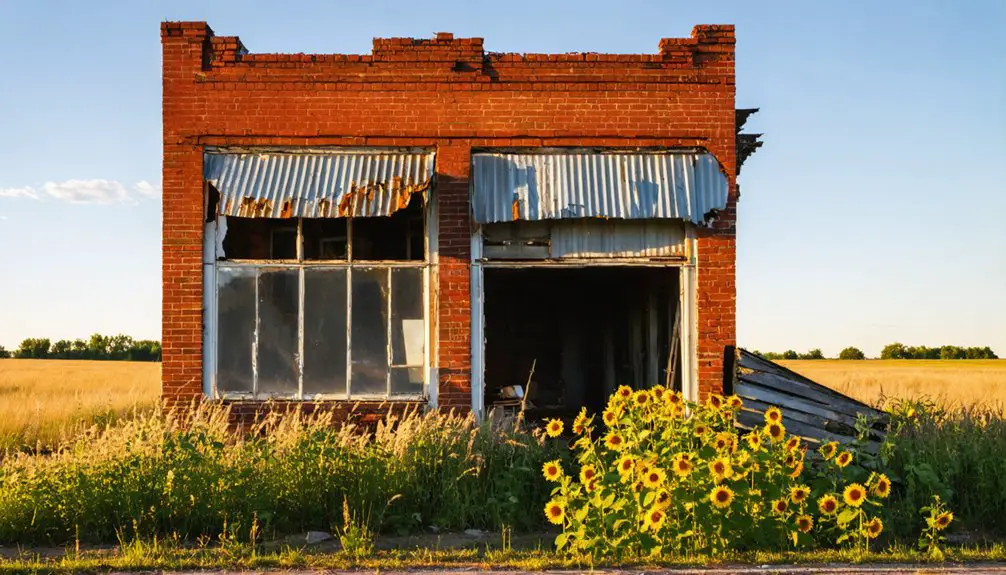You’ll find Achilles, Kansas nestled in history as a frontier town established in the late 1870s by Armstead Morris. Named after his father Achilles, the settlement peaked between 1887-1910 with about 75 residents, two general stores, and daily stagecoach connections to Colby. Near the site of the 1875 Battle of Sappa Creek, this once-promising trading post declined after a devastating 1911 fire and unfulfilled railroad promises. The empty fields today hold countless untold stories.
Key Takeaways
- Achilles was established in the 1870s as a trading post with a peak population of 75 residents and diverse Main Street businesses.
- A devastating fire in 1911 destroyed key businesses, marking the beginning of the town’s decline into ghost town status.
- The town’s failure to secure promised railroad connections significantly contributed to its economic downfall and eventual abandonment.
- Located near the historic Battle of Sappa Creek site, where a violent conflict occurred between U.S. Cavalry and Cheyenne Indians.
- Today, only empty fields remain where the once-thriving frontier community existed, with its post office and businesses long closed.
Origins and Early Settlement
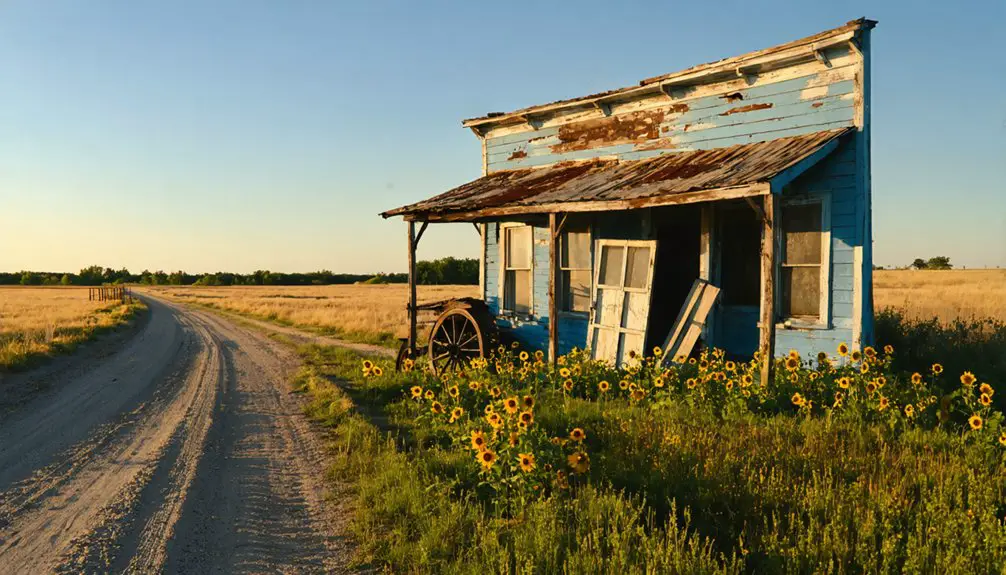
As settlers sought opportunities in Kansas during the late 1870s, Armstead Morris established a post office in what would become Achilles, naming the location after his father Achilles Morris.
While initial settlement patterns brought pioneering families to the area near Sappa Creek, the town wasn’t officially laid out until 1887 by Mr. and Mrs. J.W. Rush.
You’ll find that Achilles’ early development attracted roughly 75 residents, with many founding families establishing roots in Jefferson Township.
The town became a major trading center, with two general stores and various other businesses serving the local community.
The promise of a railroad expansion drew businessmen from nearby Atwood who enthusiastically purchased lots, hoping to capitalize on future growth.
The settlement’s strategic location and access to Sappa Creek made it an attractive destination for those seeking to build a new life in Rawlins County. The area’s history was marked by conflict, including the Battle of Sappa Creek in April 1875, which resulted in significant casualties on both sides.
Native American Conflicts Near Sappa Creek
While the town of Achilles was still years from establishment, Sappa Creek witnessed one of Kansas’s most violent Native American conflicts in 1875.
You’ll find the battle site where Company H of the 6th U.S. Cavalry clashed with Cheyenne Indians led by Little Bull, resulting in 27 Native American deaths, including women and children.
The battle, known to the Cheyenne as Dark Water Creek, represents a tragic chapter of Native resistance against expanding settlement and federal policies.
Known as Dark Water Creek among the Cheyenne, this violent clash symbolizes their desperate struggle against westward expansion.
You can still visit memorials marking these events, including the Indian Boy monument erected in 1900.
Second Lieutenant Austin Henely led the U.S. forces in what became the final Red River battle.
The area was once frequented by wild buffalo herds before settlers arrived.
The conflict’s aftermath sparked further resistance, including the 1878 northward flight of 300 Cheyenne under Dull Knife and Little Wolf.
Today, historical memory of these events lives on through preserved battle sites and monuments along Sappa Creek.
Peak Business and Trading Years
You’ll find Achilles reached its commercial zenith between 1887 and 1910, when it served as a principal trading hub in southwestern Rawlins County with daily stagecoach connections to Colby.
The town’s Main Street bustled with two general stores, a variety store, blacksmith, barbershop, mechanics garage, and creamery, while a money order post office facilitated trade. The town maintained a steady population of approximately seventy residents during its most prosperous years. Like many mining communities of the era, such as Mindenmines, Missouri, the town’s fortunes were closely tied to local industry.
This period of prosperity lasted until 1911, when a devastating fire destroyed the Field and Badgley Store, marking the beginning of the town’s decline.
Commercial Activity Timeline
During the early 1900s, Achilles reached its commercial pinnacle as a principal trading point in southwestern Rawlins County, with roughly 70 residents supporting a vibrant business district.
You’d have found a diverse mix of establishments driving the town’s commercial expansion, including a variety store, blacksmith shop, barbershop, and mechanics garage. The trading dynamics centered around essential services like the post office, which offered money order capabilities and connected to Colby via daily stagecoach mail delivery. Like many ghost towns in Kansas, including Cedar Point’s mill, the remnants of these commercial buildings serve as silent testaments to the area’s bustling past. The development of major highways diverted traffic and customers away from small towns like Achilles, gradually diminishing its commercial viability.
A Methodist Church served the spiritual needs of the community until its later relocation to Atwood. While local businesses thrived briefly, the town’s anticipated railroad connection never materialized, ultimately limiting Achilles’ potential for sustained economic growth.
Local Business Operations
At its commercial height, Achilles boasted a concentrated business district that served both local residents and regional traders.
You’d find impressive business diversification along Main Street, where two general stores, including Hill General Store, anchored the town’s retail offerings. The Field and Badgley Store was particularly notable for fostering community engagement until its destruction in the 1911 fire. Like many Kansas towns affected by diminishing mineral deposits, the business district gradually saw declining patronage. The shift away from railroad transportation contributed significantly to the town’s economic decline.
- Daily stagecoach service connected you to larger markets like Colby
- A local creamery processed dairy products from area farms
- The blacksmith shop kept your tools and equipment in working order
- Money order services at the post office facilitated your business transactions
The town’s strategic position made it southwestern Rawlins County’s primary trading point around 1910, supporting a population of 70-75 people during peak operations.
Transportation and Economic Challenges
While many frontier towns flourished with the arrival of railroads, Achilles, Kansas faced a crippling setback when promised rail lines never materialized.
Without essential transportation infrastructure, the town struggled to maintain its position as a trading hub in southwestern Rawlins County. You’ll find that local merchants and businessmen, who’d invested based on railroad promises, watched their prospects dim as economic stagnation set in.
Failed railroad promises left local merchants watching their investments crumble as Achilles lost its economic foothold in Rawlins County.
The town’s reliance on stagecoach services to Colby limited the flow of goods and people, increasing costs and reducing profit margins for local enterprises.
You can trace Achilles’ decline as businesses and settlers chose neighboring towns like Atwood and Colby, which enjoyed railroad connections. These communities thrived along major cattle shipment routes while Achilles remained isolated, eventually leading to its demise.
The Devastating Fire of 1911
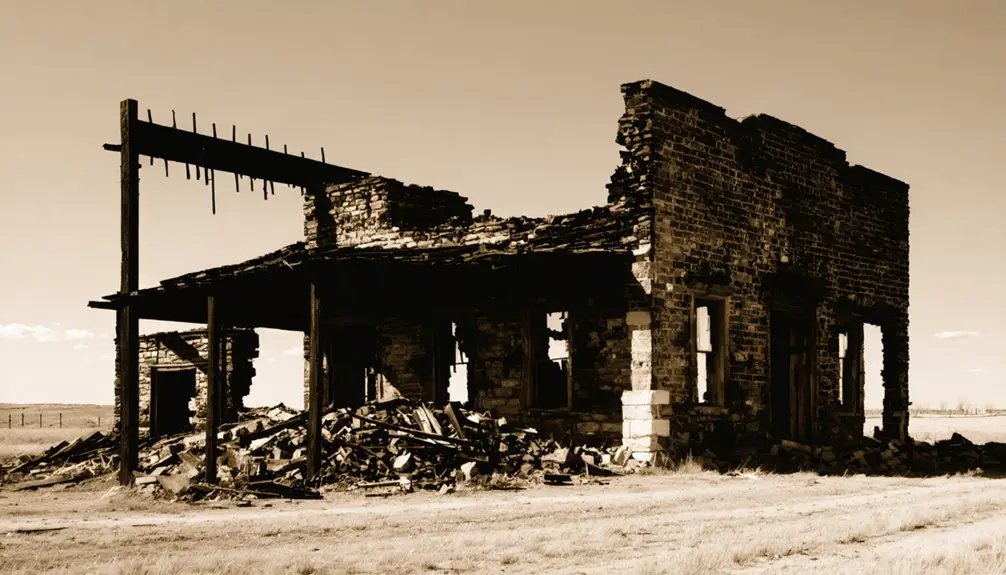
A devastating fire in 1911 marked the beginning of Achilles’ final decline, destroying the town’s commercial heart and several key businesses including the essential Field and Badgley Store.
While the exact fire causes remain unclear, the community impact was profound, accelerating the town’s transformation into a ghost town.
You’ll find this blaze was part of a larger pattern of destructive fires that struck Kansas towns that year, including Courtland, Jamestown, and Glasco.
- The fire destroyed the town’s main trading hub, crippling local commerce
- Multiple businesses along Main Street never reopened after the destruction
- The Methodist Church was later moved to Atwood, signaling community dispersal
- Within decades, the post office closed and Achilles became virtually abandoned
Vanishing Buildings and Infrastructure
Once vibrant with commercial activity, Achilles’ Main Street has lost all traces of its former business district, including two general stores, a variety store, blacksmith shop, barbershop, mechanics garage, and creamery.
The ghost town dynamics that sealed Achilles’ fate began when the anticipated railroad bypassed the town, followed by the devastating 1911 fire that destroyed a key store.
You’ll find no building preservation success stories here – even the Methodist Church was relocated to Atwood and converted into a residence.
The post office, established in 1879, closed decades ago, and former stagecoach routes have vanished.
Nature has reclaimed the site, with vegetation overtaking old foundations.
Like many Kansas ghost towns, Achilles’ infrastructure succumbed to economic decline, leaving only empty fields where a community once thrived.
Legacy in Kansas Frontier History
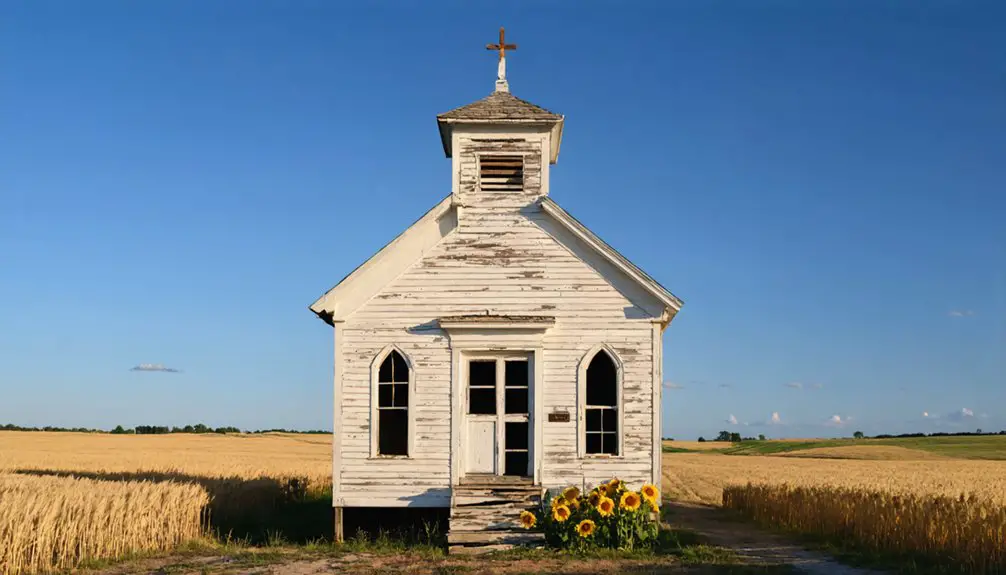
Established during the tumultuous post-Civil War westward expansion, Achilles exemplifies both the ambitions and struggles of Kansas frontier settlements.
You’ll find this ghost town’s story deeply intertwined with the complex dynamics of frontier resilience, from violent conflicts between settlers and Native Americans to the settlement aspirations that drove community development.
- Near the Battle of Sappa Creek site, Achilles bears witness to the often tragic encounters between cultures during westward expansion.
- Named after Armstead Morris’s father, the town reflects the personal dreams of frontier families seeking new opportunities.
- As a trading hub with 70-75 residents at its peak, it showcased the economic potential small settlements hoped to achieve.
- The town’s eventual decline mirrors broader patterns of rural transformation, where technological progress reshaped Kansas’s agricultural landscape.
Frequently Asked Questions
What Happened to the Descendants of Achilles Morris, the Town’s Namesake?
You won’t find clear descendant stories, as historical records don’t track Achilles Morris’s family legacies. After his son Armstead named the post office, the Morris descendants likely scattered, leaving no lasting local presence.
Were There Any Notable Crimes or Lawlessness During Achilles’ Peak Years?
Unlike the Wild West tales you’re familiar with, you won’t find significant crime statistics or law enforcement records from Achilles’ peak years – the small town maintained relative peace and order.
Did Any Famous Pioneers or Historical Figures Ever Visit Achilles?
You won’t find documented pioneer visits or historical figures in Achilles’ records. Despite nearby events like the Battle of Sappa Creek and Little Wolf’s passage, no famous personalities ever stopped there.
What Was the Average Property Value of Lots in Achilles?
You won’t find specific historical property market data for Achilles lots, though Kansas’ rural land values were generally low. Today’s remote ghost town locations typically command minimal prices in the property market.
Did Achilles Have a School System During Its Active Years?
You can’t confirm with certainty whether Achilles had a formal school system, though its 1880s population of 75 residents suggests some local education existed during the town’s brief active history.
References
- https://fhsuguides.fhsu.edu/kansasheritage/rawlinscounty
- https://legendsofkansas.com/achilles-kansas/
- https://motorvero.com/public/blogs/cars-for-sale-achilles-ks
- https://legendsofkansas.com/kansas-ghost-town-list/
- https://en.wikipedia.org/wiki/List_of_ghost_towns_in_Kansas
- https://www.youtube.com/watch?v=gkfXLg-ftys
- https://legendsofkansas.com/columbia-ghost-town/
- https://americanarchive.org/catalog/cpb-aacip-b47f722c560
- https://en.wikipedia.org/wiki/Battle_at_Sappa_Creek
- https://lmu.primo.exlibrisgroup.com/discovery/fulldisplay?docid=alma991009679069708066&context=L&vid=01LMU_INST:Hannon&lang=en&search_scope=Main_CDI&adaptor=Local+Search+Engine&tab=Everything&query=sub,contains,Creek+Indians+Wars


